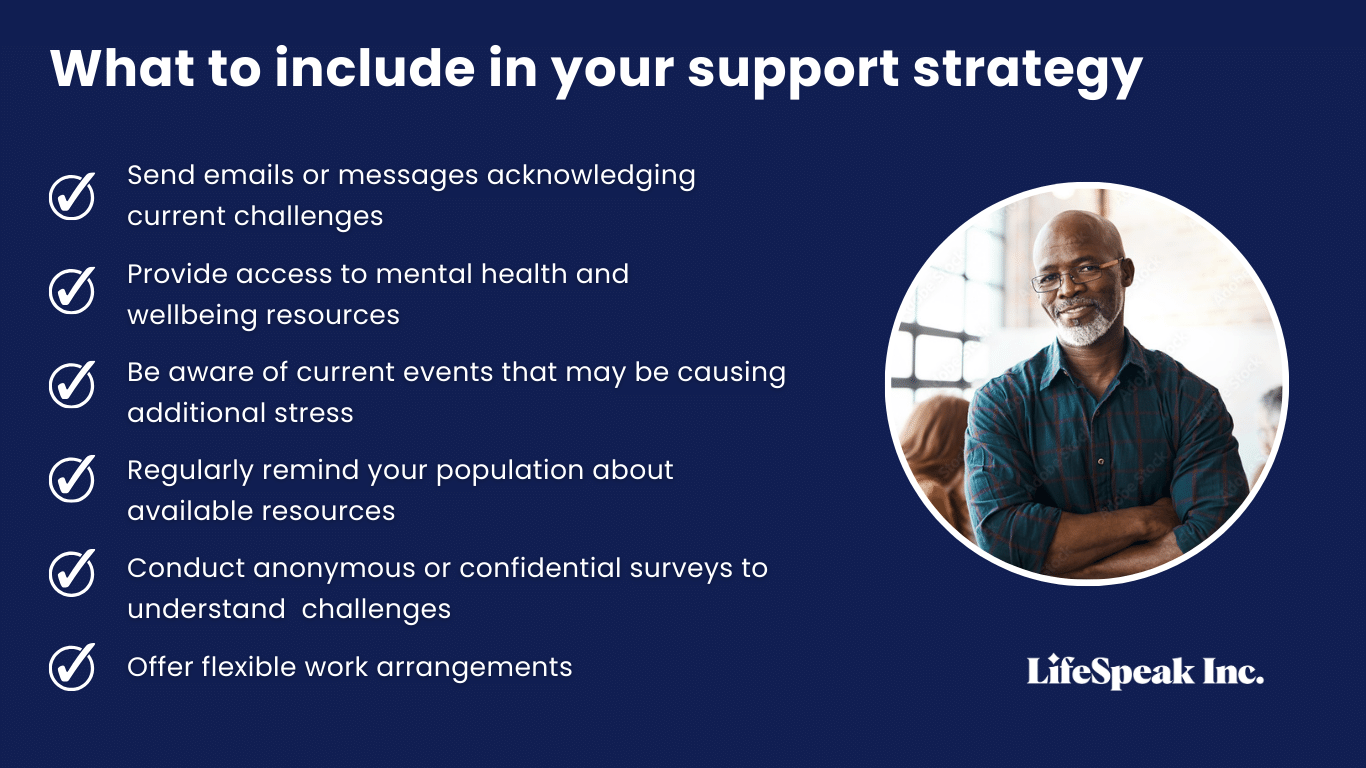How to Support Employee Mental Health in Stressful Times
How to Support Employee Mental Health in Stressful Times
Between global conflicts, mounting day-to-day pressures, and personal challenges, most of your employees are likely dealing with a significant amount of stress. Which means showing up fully at work each day can be challenging. A recent report from the American Psychological Association showed that the prevalence of mental health issues is on the rise. While 31% of adults ages 35 to 44 reported having a mental health diagnosis in 2019, that number grew to 45% in 2023.
So, how can employers and organizations help to support employee mental health in the face of stressful, polarizing events?
While external events are clearly out of your realm of control, organizations can focus on practical strategies for building resilience by using tools to proactively recognize and address mental health issues and working to reduce the stigma that surrounds them.
In a LifeSpeak Inc. webinar, “Blueprint for Resilience: Supporting Organizational Wellbeing in Turbulent Times,” clinical psychologist Dr. Marissa Alert shared strategies to counter these impacts and foster organizational resilience amid disruption. She provided actionable tools and insights organizations can use to help employees strengthen their “resilience muscles” through challenging times.
Check out some webinar highlights below, or view the webinar on demand here.
In this article:
- Understanding employee stress
- The stress response: what is a ‘normal range’?
- Why mental health matters at work
- Support strategies for organizations
- What to include in your support strategy
- Facing a crisis: how to provide immediate support
- Building a resilient organizational culture
- Lead by example
- Explore more strategies to support employee mental health in times of stress
Understanding employee stress
The impact of the ‘pile up’
Everyone experiences stress differently. But there are some universal ways it shows up in people’s lives. Feelings of prolonged stress, strain, anxiety, or sadness make it harder to focus, learn new things, and interact normally with others–especially in a work setting where there is pressure to be ‘always on.’ While identifying when your employees are stressed, anxious, or depressed is not always easy, it’s important to remember that, in general, mental health struggles interfere with people’s ability to process information, focus, and be present at their jobs.
“Watch for signs like worry, sadness, anger, or difficulty concentrating.“
The stress response: what is a ‘normal range’?
There is no one size fits all ‘tell’ to gauge overall stress levels. Everyone will respond individually based on their resilience and coping abilities. So how can leaders identify critical stress levels from a wide range of physical, cognitive, emotional, and behavioral changes? Watch for signs like worry, sadness, anger, or difficulty concentrating. Even though these signals can crop up in typical situations, keep an eye out for overall changes in daily functioning.
If you see an employee struggling with anything on the list below on a regular basis, they might be reacting to stress:
|
|
One thing to note is that leaders may not always know the underlying reasons why an employee is struggling. The key isn’t to try and pinpoint the exact causes of their stress, but rather to identify when signs of strain are occurring– without making assumptions about the reasons behind it. The goal should be to offer support and resources to help alleviate the employee’s distress in a solution-focused manner, not to assign blame or delve into figuring out faults. The priority is on supporting the employee’s wellbeing, not determining causation for performance issues. By noticing distress and responding compassionately without judgment, leaders can help empower employees to manage stressors more effectively.
Why mental health matters at work
Most people flow through a range of emotions during any given work week. But when employees experience persistent low wellbeing, the impact can be felt throughout the workplace. People bring their whole selves to work, and despite their best efforts, mental health issues can result in less motivation, missed days, workplace conflict, medical costs, and more.
These impacts create both direct and indirect costs for overall organizational wellbeing, such as:
|
“When systemic safeguards are already in place, it becomes easier for organizations to get ahead of issues before they become problematic.“
Support strategies for organizations
Create a culture of caring
We hear a lot about creating a culture of caring, but what does this mean in practical terms? One of the best ways for organizations to get started is to proactively implement support strategies and policies. When systemic safeguards are already in place, it becomes easier for organizations to get ahead of issues before they become problematic.

What to include in your support strategy:
- Send emails or messages acknowledging current challenges and let employees know leadership understands what they may be facing. These reassuring messages help reduce stigma and feelings of isolation.
- Provide access to mental health and wellbeing resources like low barrier, free resources and tools such as LifeSpeak Inc.’s mental health and wellbeing suite. If you have an EAP program or cover counseling services, make sure your employees are aware and understand how to access them.
- Regularly remind your population about available resources through multiple communication channels. Repeated reminders help ensure stressed employees know where to turn for support when they need it.
- Be aware of current events that may be causing additional stress. Election seasons and political or religious topics can trigger strong emotions for some. People may feel alone in struggles related to their personal beliefs or values. While discussing sensitive societal issues may not be appropriate at work, leaders should recognize that events happening outside of work could be impacting employees’ mental wellbeing. Staying informed about potential stress triggers in the broader environment can help leaders understand when extra support may be needed.
- Conduct anonymous or confidential surveys to understand the mental health and wellbeing challenges employees are experiencing. Gathering feedback aids in targeting resources to actual needs and paves the way for planning around particularly stressful times.
- Offer flexible work arrangements allowing for adjusted schedules, remote workdays, or leaves of absence for mental health when needed. Greater flexibility reduces stress for anyone coping with challenges.
Facing a crisis: how to provide immediate support
When employees experience acute stress, anxiety, or other mental health challenges, employers need to provide swift, supportive measures. Doing so can help to prevent the situation before it becomes a disability claim and get staff the assistance they need in the moment.
How to offer immediate support:
- Check-in calls or virtual meetings: Scheduling individual check-in calls or video meetings allows managers to privately gauge an employee’s mental state and offer help. It also opens a line of two-way communication for addressing concerns.
- Modified or reduced work duties: For staff feeling overwhelmed, temporarily adjusting tasks, or reducing hours can alleviate pressing demands. This eases stress and allows time to focus on self-care without putting one’s job at risk.
- Time off or sick leave approval: For those having difficulty functioning due to acute anxiety or other conditions, offering unplanned paid leave provides needed respite. This assures staff that it is acceptable to independently focus on mental wellbeing.
- Referrals to resources: Providing immediate referrals to counseling services, crisis hotlines, or other programs to connect employees to trained help during difficult times. Doing so shows a proactive commitment to supporting mental health.
- Expressions of care and concern: Simple acts like sending a thoughtful email or note to convey care, concern, and offers of help can lift morale and reassure struggling staff that they are not alone.
“Boosting awareness and addressing issues goes a long way to creating a culture where employees feel comfortable accessing support without fear of judgment.“
Building a resilient organizational culture
Destigmatize mental health issues
Mental health challenges are extremely common yet often stigmatized in the workplace. Employers can help change this culture by working to destigmatize these concerns. Companies should make it known that mental health is equally as important as physical health. No one should feel shame in seeking help.
Consider conducting regular assessments, such as anonymous surveys or interviews. This type of feedback allows organizations to gain meaningful insights that can help reduce mental health stigma. Which in turn also strengthens workforce resilience, especially when paired with actively promoting mental health resources and encouraging employees to seek help, through strategic internal communications.
Assessments can uncover the current company culture, assess pain points, and identify anything negatively impacting wellbeing. With knowledge of challenges, employers can implement positive changes to systems, communications, and the overall work environment. Boosting awareness and addressing issues goes a long way to creating a culture where employees feel comfortable accessing support without fear of judgment.
Lead by example
To effectively implement mental health initiatives and support staff, organizations should prioritize increasing mental health literacy at all levels. Identify executive sponsors who can champion initiatives through communication and resource allocation, which can expedite cultural change.
Providing in-depth training to leadership and managers equips them to recognize issues, have difficult conversations, and lead by example in cultivating psychologically safe teams.
Company-wide training and educational materials help foster an understanding of common conditions, available support, and how to help others. Additional skills-based training can teach empathy, trust-building, effective communication strategies, facilitating wellbeing practices, and cultivating an inclusive environment where people feel comfortable disclosing challenges.
A well-educated workforce is empowered to look out for one another and know where to turn, thereby reducing stigma and normalizing support-seeking behaviors.
By fostering a culture of compassion and psychological safety, leaders can positively influence mental health during stressful events, and create spaces where people feel comfortable opening up about what is on their minds. While news cycles, election anxiety, and distressing headlines may negatively impact mental health, organizations can proactively support wellbeing as employees navigate both global conflicts and personal struggles alike. The key lies in cultivating robust support systems from the ground up.
“Building resilience is key to helping employees better manage stress, especially during challenging times.“
Explore more strategies to support employee mental health in times of stress
For more valuable insights and tangible tools to build resilience and cultivate a thriving workforce amid global stressors, listen to the LifeSpeak Inc. webinar, “Blueprint for Resilience: Supporting Organizational Wellbeing in Turbulent Times,” as clinical psychologist Dr. Marissa Alert shared strategies to counter these impacts and foster resilience during times of stress. View the webinar on-demand here.
Building resilience is key to helping employees better manage stress, especially during challenging times. As leaders, we want our people to feel supported both in their work and personal lives.
Looking for proactive ways your organization can help employees navigate the impacts of current events? LifeSpeak Inc.’s corporate wellbeing solutions can help your members better understand key issues that affect mental health and take positive action through on-demand, expert resources, tools, and microlearnings.

